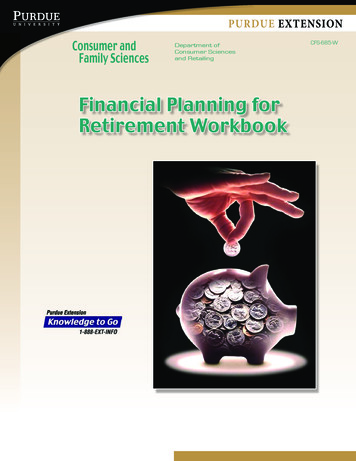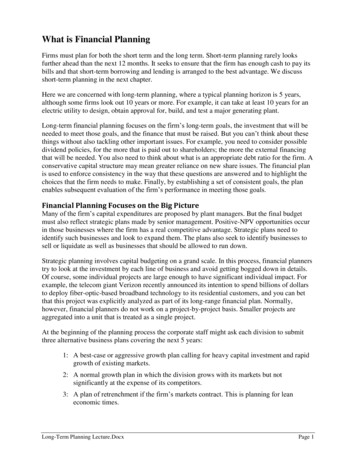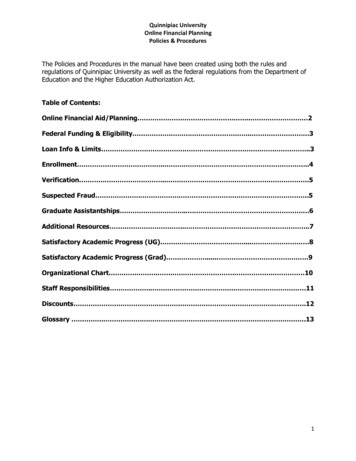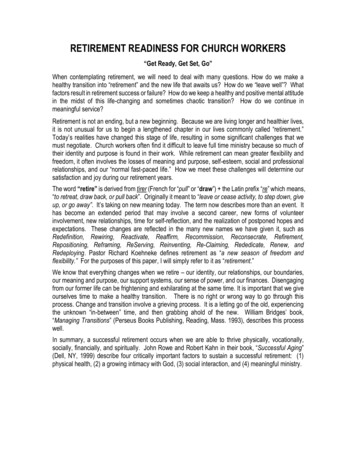
Transcription
Purdue ExtensionConsumer andFamily SciencesDepartment ofConsumer Sciencesand RetailingFinancial Planning forRetirement WorkbookCFS-685-W
Financial Planning for Retirement Workbook CFS-685-WPurdue ExtensionFinancial Planning for RetirementWorkbookRevised and updated by Janet C. Bechman, Purdue Extension specialist, andBarbara R. Rowe, Utah State University Cooperative Extension specialist,based on North Central Regional Extension publication 264 by Irene Hathaway,Michigan State UniversityTable of Contents WorksheetsIntroduction3Your Retirement Lifestyle3Your Current Financial Situation4The Inflation Factor7Changes in Spending PatternsAfter Retirement8Planning for Future Inflation8Planning for Large Future8Irregular Expenses11How Much Are You Worth?Estimating Retirement Income11Where to Go for Information18Balancing Income with Expenses1818Increasing IncomeReducing Expenses22Medicare and Other Health Insurance22Housing Expenses23Looking Ahead2325ReferencesCredits25Worksheet 1 – Your Retirement Lifestyle5Worksheet 2 – Estimated Annual Costof Living6Worksheet 3 – Estimated Changes in SpendingAfter Retirement9Worksheet 4 – Estimated Annual Cost ofLiving 10 Years After Retirement 12Worksheet 5 – Large Future IrregularExpenses1314Worksheet 6 – How Much Are You Worth?Worksheet 7 – Estimated Annual Income19After RetirementWorksheet 8 – Estimated Annual Income2010 Years After RetirementWorksheet 9 – Monthly Cost of LivingWorksheet24TablesTable 1. The Inflation Factor7Table 2. Expectation of Life by Ageand Sex10Table 3. Age to Receive Full Social15Security BenefitsTable 4. Benefit Increases forDelayed Retirement16
Financial Planning for Retirement Workbook CFS-685-WIntroductionYour Retirement LifestyleAre you looking forward to the day you retire?To having more time to travel, spend with familyand friends, enjoy new hobbies, or increase yourvolunteer work? Or does the thought of retirementmake you slightly uneasy; unsure if you will haveenough money to stop working, but not knowing howmuch you need to save? Being able to retire whenyou want and living comfortably is a dream for manyAmericans, and the goal of this workbook is to helpyou reach it.As you think about your retirement days, how willyou want to live? What type of lifestyle do you hopefor? Will you have enough money to support thatlifestyle? What will be important to you and whatwon’t be? How will your life and expenses changeafter retirement? Here are some items to consider: Your home —Where will you live? Changing yourhousing or moving to a different part of the stateor country, or to another country, can increase ordecrease your expenses. Even if you plan to “stayput” in the same house, some of your costs will stillchange. For example, your heating and light billsmay increase if you spend more hours at home. Orthey may decrease if you spend more time travelingaway from home. As your home ages, it will needmore repairs and maintenance.The biggest question is, when the time comesto stop working, will you have enough income tocontinue the lifestyle you had before retirement? Thatdepends on the lifestyle you want to maintain andthe types of income you will have. Social Securitypayments alone will not be enough for most of us. In2009 the maximum Social Security monthly benefitpayable to a worker retiring at age 66 was 2,323,while the average monthly benefit was 2009.htm). Transportation — What does it cost you now?How much of your transportation costs (gas, carmaintenance, bus or train fares) are for travel toand from work? Will you keep your own car, relyon public transportation exclusively, or use somecombination of the two?As you plan, keep in mind that the averageAmerican life expectancy is 74.7 years for men and80.0 years for women.1 The “average” person whoretires at age 65 looks forward to another 16 to 20years of life. Many of us will have even more years. Itis never too early to begin planning how you want tospend those years. Food — Will you eat out more often in retirement,or entertain friends and family more often? Howmuch do you pay a year for lunches or other mealseaten at work? Clothing and personal care — How much of yourpresent clothing costs are for special clothing foryour job? How much is for more expensive clothingthan you will need after retirement?When you think ahead to retirement, here are somequestions to answer:1. What lifestyle will you want during retirement?2. What is your current financial situation? Health and medical expenses — Will you buyinsurance to supplement Medicare gaps, or will yoube paying for all your health care insurance untilyou are age 65? Will you buy exercise equiment,or join a health club, or cancel a health clubmembership?3. How will your financial situation change atretirement?4. How can you control your financial future to beable to retire with the resources needed to achieveyour desired lifestyle? Entertainment — Will you spend more or less onmovies, books, theater, clubs, shopping?See how your retirement picture might look byfollowing the steps in this workbook, filling in theworksheets, and doing the calculations. No one canpredict the future exactly. However, projecting fromwhat you know now will give you an estimate of whatto expect in the future.1Purdue Extension Hobbies — Will you spend more money onhobbies, such as woodworking and gardening? Recreation — Will you spend more money onleisure activities, such as golfing and fishing?Source: National Vital Statistics Reports, Vol. 54, No. 14,April 19, 2006 Retrieved from www.cdc.gov/nchs/data/nvsr/nvsr54/nvsr54 14.pdf Travel — Will you increase your travel duringretirement?After you retire, you may spend more in certaincategories such as health care and health insurance.
Purdue ExtensionFinancial Planning for Retirement Workbook CFS-685-Wmultiply by 12 to get the annual figures to put onWorksheet 2.You also may spend more on travel, entertainment,and leisure activities, because you have more time toenjoy them.Note: The sample “Estimated Annual Cost ofLiving” worksheet on this page is meant to serve asa guide as you fill in your Worksheet 2. It is based onthis scenario:Use Worksheet 1, “Your Retirement Lifestyle”(page 5), to describe the lifestyle you desire duringretirement. As you dream about your retirementdays, will you be able to afford the lifestyle you finddesirable?a) Mr. and Mrs. Jones would like to retire at age 62,11 years from now.Your Current Financial Situationb) They guess that the inflation rate will rise slowlyand will average about 5 percent a year.As you plan for your retirement years, it is helpfulto look at what you are spending now to live. UseWorksheet 2, “Estimated Annual Cost of Living”(page 6), to record what you spend annually in eachcategory. If you only have monthly expense figures,turn to the “Monthly Costs of Living,” Worksheet9 (page 24). Record your monthly expenses andc) 11 years at 5 percent 1.71 inflation factor (fromtable on page 7).d) Their estimated current annual expenses of 32,277, multplied by the inflation factor of 1.71,shows they will need 55,194 in their first year ofretirement to maintain their current lifestyle.Example: Estimated Annual Cost of LivingTotals YouSpend NowInflationFactorFuture Budget atTime of Retirement in11 yearsHousing 9,9561.71Household operation and maintenance 2,2301.71 3,813Automobile and transportation 6,0161.71 10,287Food 4,5181.71 7,726Clothing 1,7821.71 3,047Personal 1,5211.71 2,601Medical and health 1,6651.71 2,847Recreation, education 1,6591.71 2,837 7381.71 1,262 1,1121.71 1,902Savings, investments 7801.71 1,333Irregular expenses(ex. gifts, license plates, holiday spending,etc.) 3001.71 513 32,2771.71 55,194ContributionsTaxes and insuranceANNUAL TOTALAdapted from Planning a Retirement Budget, a CEH Topic, Hogarth, Cornell University, 1984. 17,025
Financial Planning for Retirement Workbook CFS-685-WPurdue ExtensionWorksheet 1 – Your Retirement LifestyleWhat will your lifestyle be like during retirement? Beside each item listed below, describe what youreally want in retirement.1. Your home:2. Transportation:3. Food:4. Clothing and personal care:5. Health and health care:6. Entertainment:7. Hobbies:8. Recreation:9. Travel:From Retirement Planning, DP-CFR-051, Maddux, University of Georgia CES, 5/96.
Financial Planning for Retirement Workbook CFS-685-WPurdue ExtensionWorksheet 2 – Estimated Annual Cost of LivingFill in the first column with what you are now spending annually to live. Then figure theInflation Factor by following the steps listed above the Inflation Factor table on page 7. Fillin the inflation factor in the second column. (You may do this only for the total, or for eachcategory of costs.) Multiply column 1 by column 2 to get an idea of the income you will needduring your first year of retirement.Totals YouSpend NowInflationFactorFuture Budget atTime of Retirementin yearsHousing Household operation and maintenance Automobile and transportation Food Clothing Personal Medical and health Recreation, education Contributions Taxes and Insurance Savings, investments Irregular expenses(ex. gifts, license plates, holiday spending,etc.) ANNUAL TOTAL Adapted from Planning a Retirement Budget, a CEH Topic, Hogarth, Cornell University, 1984.
Purdue ExtensionFinancial Planning for Retirement Workbook CFS-685-W(1) Choose the number of years until yourretirement starts from the “Years to Retirement”column on the left of Table 1.The Inflation FactorInflation is a widespread and sustained increasein the general price level of goods and services.Economists say that when prices go up 3 percentor more a year, the country is in a state of inflation.While just about everyone gets hurt by inflation,people who live on fixed incomes may feel thecrunch more than others because prices rise but theirincome doesn’t. Increases in inflation rates have beenextremely modest in recent years – between 2 percentand 4 percent. But even a 2 percent increase everyyear will have a cumulative effect, and prices will behigher in the future than they are now. That’s why itmakes sense to build inflation into your retirementplans.(2) Then select an estimated annual inflation ratefrom the row across the top. Inflation cannot bepredicted from year to year. In 1980, it was 12.4percent. In 2001, it was 1.6 percent. In 2007, it was4.1 percent. You have to make an educated guess.(3) Read across and down to find the appropriateinflation factor corresponding to your predicted rate ofinflation. For example, 10 years at 6 percent inflationgives a factor of 1.79.(4) Multiply your estimated annual cost of livingexpenses from the first column of Worksheet 2 by theinflation factor to get an idea of the amount of incomeyou will need for your first year of retirement, if youwant to maintain your current lifestyle. (Example: 14,000 x 1.79 25,060.)On Worksheet 2, “Estimated Annual Cost ofLiving,” you filled in the first column with the costyou calculated for each of the expense categorieslisted. To fill in the second column, use Table 1, “TheInflation Factor” (on this page).Table 1. The Inflation FactorAnnual Inflation RateYears .906.547.268.06From Financial Planning for Retirement, NCR-264, Field and Hathaway, Michigan State University CES, 5/87.
Financial Planning for Retirement Workbook CFS-685-WPurdue ExtensionChanges in Spending PatternsAfter RetirementPlanning for Future InflationIncome taxTo see how inflation will affect your budget into thefuture, turn to Worksheet 2 (page 6). Copy the totalsfrom the right-hand column, “Your Future Budget atTime of Retirement in Years” into Column 1on Worksheet 4, “Estimated Annual Cost of Living10 Years After Retirement” (page 12). Then go backto Table 1, “The Inflation Factor” (page 7). Choosean inflation rate and find the factor for 10 years.Multiply that factor by the figures in column one onWorksheet 4. Record your answers on column threeof Worksheet 4.On Worksheet 2, “Estimated Annual Cost ofLiving,” you calculated the effects of inflation on yourliving expenses until you retire. But inflation willcontinue, at some rate, after you retire. A man retiringtoday at age 65 can expect to live 16.8 more years; awoman, 19.7 more years (See Table 2, “Expectationsof Life by Age and Sex” (page 10). How will yourexpenses be affected by inflation then?After you retire, you may spend less on certaincategories, such as taxes (income taxes are usuallylower, and you may not pay Social Securitytaxes, although some retirees do) and savings andinvestments (you probably won’t contribute to apension fund, although you still will need a savingsplan).How much did you pay last year? Compare thatamount with the taxes for your estimated retirementincome. Use the table in last year’s 1040 form. Aboutone third of people who get Social Security have topay taxes on their benefits. This provision affects onlypeople with substantial income in addition to theirSocial Security benefits. Pension or annuity paymentsfrom an employer’s retirement plan may be subject toincome taxes.Social Security taxesHow much will inflation increase your living costs?Even a moderate rate of inflation will push up thosecosts over time. This shows that it will be necessaryto plan for retirement income that will keep pace withinflation as much as possible. The example on page 11assumes an annual average inflation rate of 5 percent.If you continue to work after you begin drawingyour Social Security benefits, you will have to paySocial Security and Medicare taxes on your earnings.In 2009, the combined tax rate was 7.65 percent foran employee and 15.3 percent for a self-employedperson. You do not have to pay Social Security orMedicare taxes on your Social Security income.Planning for Large FutureIrregular ExpensesCheck your paycheck stub for the amount you paidinto Social Security last year. Compare it with theexpected amount of your post-retirement income.That will tell you whether you will need to pay SocialSecurity taxes after retirement and how much theywill be.Some expenses do not occur every month, oreven every year. These are the ones you are mostlikely to not plan for (a new roof, an appliance thatdies, another car). These expenses are most likely tointerfere with your retirement budget.Saving and investing in retirementUse Worksheet 5, “Large Future IrregularExpenses” (page 13), to help you plan ahead for someof these large expenses. This worksheet will help youanswer some basic questions as you plan ahead foryour large expenses. Think about when you expectthe expense to occur and the estimated cost. Do someyears have more expenses than others? Can you shiftsome of those costs to other years? Or, can you setaside savings in less expensive years to pay for them?Can good maintenance and/or repairs lengthen the lifeof some items so they won’t have to be replaced sosoon? Can you live with certain items after they areno longer in tip-top shape? Are there some items youwon’t replace as they wear out? What can you replacebefore you retire when you may have more moneyto pay for them? (Note: The average life expectancyCheck your paycheck stub for contributions toa pension plan. How much are you investing forretirement in other ways, including mutual funds,stock market accounts, and IRAs?For each expense category, figure the differencebetween what you’re spending now and what youexpect to spend after retirement. Enter those amountsonto Worksheet 3, “Estimated Changes in SpendingAfter Retirement” (page 9). If your retirement expensewill be lower, put the difference in the “less” column.If the expense will be higher, put the difference in the“more” column. Then compare the totals.
Purdue ExtensionFinancial Planning for Retirement Workbook CFS-685-WWorksheet 3 – Estimated Changes in Spending After RetirementUse this worksheet to calculate possible changes in your expenses. For each expense category, figurethe difference between what you are spending now and what you expect to spend after retirement. Ifthe retirement expense will be lower, put the difference in the “less” column; if it will be higher, put thedifference in the “more” column. Add the figures in both columns and compare the totals. Which total islarger? What does that suggest about your future spending? Will you need to make some changes in whatyou expect to spend?ExpenseNow SpendAbout HowMuch?Expect toSpend AfterRetirementLess AfterRetirementMore AfterRetirementWork related:TransportationClothingDuesMealsOther Social Security taxes(taken out of check) Income taxes Contributions to otherretirement accounts(IRA, etc.) Savings, investmentsfor retirement Pension plan contributionsTravelEntertainment, leisureactivities Health insurance Other health care costs Less MoreTOTALSAdapted from Financial Planning for Retirement, NCR-265, Field and Hathaway, Michigan State University CES, 5/87.9
Financial Planning for Retirement Workbook CFS-685-WPurdue ExtensionTable 2: Expectation of life by age and talAll .57.05.03.52.5Source: National Vital Statistics Report, Vol. 54, No. 14, April 19, 2006, Report revised March28, 2007.Retrieved Aug. 5, 2009www.cdc.gov/nchs/data/nvsr/nvsr54/nvsr54 14.pdf10
Financial Planning for Retirement Workbook CFS-685-WHousingPurdue ExtensionExample: Estimated Annual Cost of Living 10 Years After RetirementYour BudgetYour Budget atInflation10 Years AfterRetirementFactorRetirementHousehold operation and maintenance 17,025 3,8131.631.63 27,751 6,215 7,726 3,047 2,6011.631.631.63 12,593 4,967 4,240 10,287Automobile and transportationFoodClothingPersonalMedical and health 2,8471.631.63 16,768 4,641Recreation, education 2,8371.63 4,624Taxes and insuranceSavings, investments 1,9021.63 3,100 5131.63 836 55,1941.63 89,966 1,262Contributions 1,333Irregular expenses(ex. gifts, license plates, holidayspending, etc.)ANNUAL TOTAL1.631.63 2,057 2,173From Financial Planning for Retirement, NCR-264, Field and Hathaway, Michigan State University CES 5/87.estimates listed on Worksheet 5 are just a guide. Youritems may last longer or may need to be replacedsooner.)Every year, perhaps at the first of each year, reviewyour net worth statement and update your figures forany changes in your financial situation over the year.How Much Are You Worth?Estimating Retirement IncomeAs you develop your financial plans for retirement,you need to know the resources you already have.A net worth statement gives you that information.On Worksheet 6, “How Much Are You Worth?”(page 14), list your current assets and liabilities. Yourassets include everything you own that is of any value(like cash on hand, your checking and savings accountbalances, the current market value of bonds, stocks,and other investments). Your liabilities include theoutstanding balance due on the debts you owe (suchas your home mortgage or car loan, and other unpaidbills). Subtracting your liabilities from your assets willshow your net worth.Where will your retirement income come from?The primary sources of income for most retirees areSocial Security, public and private pensions, personalsavings and investments, and earnings. In 2006, SocialSecurity provided 37 percent, earnings 28 percent,public and private pensions 18 percent, and incomefrom assets, 15 percent of the income of people 65 orolder. 11Source: Income of the population 55 or older in 2006,SSA. Retrieved from www.ssa.gov/policy/docs/statcomps/income pop55/2006/index.html August 2009.Sources of Retirement Income1. Social SecurityYou may be able to get a fairly accurate estimateof your home’s value from a real estate firm, or youcan pay a professional appraiser to do this. Otherappraisers can estimate the value of antiques, jewelry,or other unique valuables (such appraisals should alsobe recorded for insurance purposes).Social Security provides a base level of income formost retired people, although it was never designedto replace all lost earnings. Knowing the amount youwill receive from Social Security will help you planyour total retirement package. Your eligibility for11
Financial Planning for Retirement Workbook CFS-685-WPurdue ExtensionWorksheet 4 – Estimated Annual Cost of Living10 Years After RetirementHousing Your Budget10 Years AfterRetirement Household operation and maintenance Automobile and transportation Food Clothing Personal Medical and health Recreation, education Contributions Taxes and insurance Savings, investments Irregular expenses(ex. gifts, license plates, holidayspending, etc.) ANNUAL TOTAL Your Budget atRetirementInflationFactorFrom Financial Planning for Retirement, NCR-264, Field and Hathaway, Michigan State University CES 5/87.12
Financial Planning for Retirement Workbook CFS-685-WPurdue ExtensionWorksheet 5 – Large Future Irregular ExpensesYearBoughtYear toReplacePresentReplacementPriceVehicles:CarOther vehiclesAverageExpectedYears ofLife*EstimatedPrice inReplacementYear? reezerFurnaceWater heaterOther12-1315111113-142025-3012 House:Roof (varies with type)FencingOther15-3020-30 Furnishings:CarpetDrapes, window treatmentsFlooring, hard surfaceFurnitureOther8-151015will vary * Calculate by counting the number of years until the replacement year. Then, choose an inflation factor from the chart onpage 7 and multiply by the “present replacement price.”Adapted from Financial Planning for Retirement, NCR-264, Field and Hathaway, Michigan State University CES, 5/87.13
Financial Planning for Retirement Workbook CFS-685-WPurdue ExtensionWorksheet 6 – How Much Are You Worth?Name DateAssetsLiabilitiesCash and cash equivalents:Past due bills for services, rent, etc.Cash on handChecking account(s)Savings account(s)Certificate of deposit (CD)Savings bondsTreasury securitiesMoney market funds/Moneymarket deposit accountsInvestment assets:StocksBondsMutual fundsReal estate:HomeOtherCash value of life insurance/annuitiesPartnership and business interestRetirement assets:IRA/Keogh accountEmployee retirement fundOtherConsumption assets:Home furnishings/appliancesSports and hobby equipmentAntiques, art, collectionsJewelry, furs, etc.Automobiles/vehiclesOther: Credit cards/charge accounts:Consumer installment debt:AutomobileOtherReal estate debt:HomeOtherTaxesPledges: charities, churches, etc.Other: Total liabilities Total assets TOTAL ASSETS LESS TOTAL LIABILITIES NET WORTH From Family Financial Planning: Preparing and Using Financial Statements, Morrow, Oregon State University CES, 199214
Financial Planning for Retirement Workbook CFS-685-WSocial Security is generally based on your lifetimeearnings record (or your spouse’s earnings record) andyour age.Purdue Extensionage without reduction, or as late as age 70 with specialdelayed retirement credits added on.”Sometimes, poor health forces people to retire early.If you are unable to continue working because of poorhealth, consider applying for Social Security disabilitybenefits. The amount of the disability benefit is thesame as a full, unreduced retirement benefit.To receive a Social Security retirement check,you (or your spouse) must have received credit fora certain amount of earnings under Social Security.Generally, you must have worked 40 quarters, or10 years. Special rules apply to the employees ofnonprofit organizations, state and local governmentemployees, and all federal employees hired beforeJanuary 1984.If you were born before 1938, you were eligiblefor your full Social Security benefits at the age of 65.However, beginning in the year 2000, the age at whichfull benefits are paid began to increase in gradual stepsfrom age 65 to age 67 (see Table 3 below).You can begin receiving benefits as early as age62 if you (or your spouse) have covered earnings forenough years. However, if you elect to take earlyretirement, the benefit amount you receive will be lessthan your full retirement benefit. This is a permanentreduction in the amount of the monthly check you willget; your benefit check will not increase when youreach full retirement age.You may choose to keep working even beyond yourfull retirement age. If you do, you can increase yourfuture Social Security benefits in two ways. Eachadditional year you work adds another year of earningsto your Social Security record. Higher lifetime earningsmay mean higher benefits when you retire.Also, your benefit will increase automatically by acertain percentage from the time you reach your fullretirement age until you start receiving your benefitsor until you reach age 70. The percentage variesdepending on your year of birth. For example, if youwere born in 1943 or later, Social Security will add 8percent per year to your benefit for each year that youdelay signing up for Social Security beyond your fullretirement age. (See Table 4, p. 16)The decision about when to start drawing benefitsisn’t the same for everybody, and which option willprovide you with the most benefits over your lifetimedepends on how long you live. People can get a roughestimate of their personal break-even point by usingthe Quick Calculator on the Social Security Web siteat www.ssa.gov/According to the Social Security AdministrationWeb site: “For most people the total amount oflifetime benefits you receive is about the same if youbegin receiving your retirement benefits as early as 62at a permanently reduced rate, at your full retirementEven if you delay retirement, be sure to sign up forMedicare at age 65. In some cases, medical insurancecosts more if you delay applying for it.Table 3. Age to Receive Full Social Security BenefitsYear of Birth1937 or 5819591960 and laterFull RetirementAge6565 and 2 months65 and 4 months65 and 6 months65 and 8 months65 and 10 months6666 and 2 months66 and 4 months66 and 6 months66 and 8 months66 and 10 months67Age 62Reductionin Months36384042444648505254565860Source: www.ssa.gov/retiredchartred.htm15Monthly .505.502.500Total 26.6627.5028.3329.1730.00
Financial Planning for Retirement Workbook CFS-685-WAs a spouse, you can receive benefits based on yourworking spouse’s benefit. Generally, this is one halfof his or her benefit at full retirement age. But theamount of your benefit will be reduced if you claim itbefore full retirement age. If you are eligible for SocialSecurity benefits under your own work record, you havethe option of choosing that benefit instead.If you are divorced (even if you have remarried),you can be eligible for benefits on your ex-spouse’srecord if you were married for at least 10 years andare age 62 or older. You must be unmarried at thetime you apply and not eligible for an equal or higherbenefit amount on your own or someone else’s SocialSecurity record.2. Retirement Plans and Other BenefitsRetirement plans are important benefits providedby private and public employers, unions, and themilitary. If you have rights to a retirement benefit,you are fortunate. Many people work in jobs whereno pensions are provided or they have not workedlong enough in any one job to earn vested rights to apension. (“Vesting” refers to the date when you areentitled to the money you and your employer havecontributed to your account, even if you leave the jobbefore you retire. If your pension rights are not vested,you will get back only your own contributions.) Manywomen over age 65 do not have survivor’s rights totheir husbands’ pensions, either because their husbandhas not chosen a survivor annuity from his employer’spension plan, or because divorce or early death of thehusband gave no rights to his widow.You should also check the record of your earningskept by Social Security to be sure it is accurate. Everyyear the Social Security Administration sends “YourSocial Security Statement,” Form SSA-7005-5MS1(1-2002), which shows your earnings record andyour potential benefits. Compare the statement ofearnings printout sent back to you with the earningsreported on your W-2 forms for the same years. If youfind any errors, either in your employer’s reporting orin the Social Security records, report them at once tothe Social Security Administration and be sure theyare corrected so your benefit will be correct when youretire.If you do have rights to a pension, what kind isit? Defined-benefit plans use a specific formula todetermine how much you will get, usually basedon your years of service and salary level. Definedcontribution plans are ones where you and/or youremployer con
Financial Planning for Retirement Workbook CFS-685-W Purdue extension Introduction Are you looking forward to the day you retire? To having more time to travel, spend with family and friends, enjoy new hobbies, or increase your volunteer work? Or does the thought of ret










